You were in space for 127 days, from July to November 2012. In the interview before your departure, you said you wanted to enjoy working in space. Did you enjoy the experience?
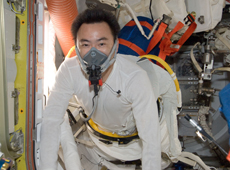
Astronaut Hoshide breathing pure oxygen before going on a spacewalk (courtesy: JAXA/NASA)
Yes, I did. To be honest with you, it was such a great experience, when it was time to go back to Earth, I didn’t want to leave. I wish I could have stayed longer. There were some challenges on board the International Space Station (ISS), such as having difficulty installing a spare device on my first EVA (extravehicular activity, or spacewalk), or the toilet breaking down. But we managed to cope with these unexpected happenings each time, working with the team on the ground. It was a very profound experience for me. Working together as a big team, not only with my crewmates in space but also with the people on the ground – I liked that very much.
Now, let me ask about the EVA. What’s the procedure you have to go through before you go outside the ISS?
First, we adjust the size of the EVA suits. An American spacesuit consists of several parts: the arms, upper torso, lower torso, etc. Each part comes in different sizes, so you pick the right ones for yourself, and make adjustments. We also have to charge batteries, and prepare cartridges for carbon dioxide removal and the tools we need for our tasks. We also review the procedure of the task we are scheduled to do on the spacewalk. The order of the tasks can be changed based on new decisions made on the ground, so we prepare for the EVA while communicating with the folks on the ground on a daily basis.
On the day of the EVA, we start preparing as soon as we get up in the morning. It takes almost five hours until we can go outside the ISS. About half that time is spent with the spacesuit on. The internal pressure inside the spacesuit is approximately 0.3 atm, and as a result there is a risk of getting decompression sickness due to nitrogen bubbles in the blood. To prevent this, we have to purge nitrogen from the body in advance. There are many ways to do this, such as spending the night before in the airlock, in lower pressure, or pedaling a bicycle while breathing pure oxygen through a mask. This time, we eliminated nitrogen by doing light exercise while inside a spacesuit filled with pure oxygen. This was the third time this new method was used.
How did you feel when you stepped out into space?
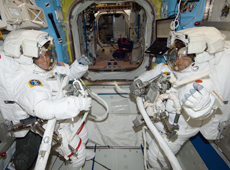
Astronaut Hoshide and his EVA partner, astronaut Sunita Williams (courtesy: JAXA/NASA)
My EVA partner, astronaut Sunita Williams, opened the airlock hatch. She went out first, and I approached the hatch with my legs first. I knew that Earth would be on the night side at that time, but it was really pitch-black around me, and I couldn’t see Earth at all. (laugh) I was happy to be in outer space, but I was already thinking about the work I had to do, so I was on to the next task right away. I understood the risks of EVA, so I had prepared enough to make sure I made no mistakes.
It was your first spacewalk. Were you afraid?
I felt no fear at all. The airlock is attached to the bottom of the ISS, facing the Earth, so you can see the Earth just below you when the hatch is open. I had heard from other astronauts that when you step out into space for the first time and see the Earth below you, you feel like you’re going to fall, and instinctively hold tight of the handrail. I was wondering if I would do that too, but unfortunately it didn’t happen to me, probably because it was during night time and it was too dark to see the Earth.
EVA training is conducted in a pool. Once you were in space, how different did you find it from the training?
A few hours after I started the spacewalk, the question came up in my mind, but I felt it was more similar than different. It looked just like the Neutral Buoyancy Laboratory, a big pool where we train for EVA, but without water and support divers. It looked that similar to the scenery I was used to in training. I think this shows how well the EVA training program is designed. I also felt that the operability of the spacesuit in general was about the same – how to move my body in it, for example. Although the internal pressure inside the spacesuit is reduced, the suit still cannot avoid inflation in the vacuum of space. The overall level of difficulty to work was about the same as in training.
What were the assignments scheduled for your first spacewalk?
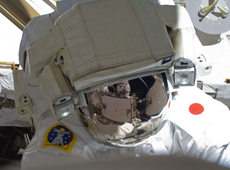
Astronaut Hoshide on his first spacewalk (courtesy: JAXA/NASA)
The main tasks this time around were to connect power cables in preparation for the future arrival of a new Russian module, and to install a spare Main Bus Switching Unit, known as an MBSU, on the ISS. An MBSU is an electric power system to distribute power from the solar array wings to the space station’s instruments. One of the four MBSUs was malfunctioning, so we were scheduled to replace it with a spare. However, we had an unexpected problem.
What happened?
The work was going smoothly until we tried to install the new MBSU – we couldn’t drive one of the bolts in all the way. NASA is always prepared for all kinds of problems, but nothing worked. The engineers on the ground immediately started looking for a solution, but they were struggling.
What was the reason for the problem?
My role in the installation was to deliver the spare MBSU by riding on the end of the station’s robotic arm. Holding the meter-long, box-shaped MBSU in my hand, I could see nothing but the box. As we were waiting for instructions from the ground, I heard Suni say that she saw some metal particles float out of the bolt socket. I moved the MBSU to the side, and I also saw some particles flying away. We won’t know for sure unless we retrieve the MBSU, but the assumption was that metal shavings were in the bolt threads.
Suni and I wanted to keep trying until the job was done. But considering that we had limited oxygen in our spacesuits and limited stamina, we were called off. A spacewalk normally lasts six and a half hours, but it can be extended depending on the status of the EVA, the consumables such as oxygen, power, and the carbon-dioxide removal system. Having said that, these are expendables, after all, and they have limits as does our stamina. Taking the day’s schedule and everyone’s stamina into account, our team on the ground decided that we needed to stop at a certain point. So, for safety reasons, we called off the EVA for that day, and tethered the partially installed spare MBSU to the ISS handrail. We had been outside for more than eight hours by then.
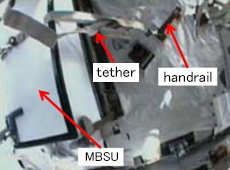
MBSU tethered to the ISS handrail (courtesy: JAXA/NASA)
Eight hours! You must have been very tired.
I was preoccupied with how we could install the spare MBSU, even after we got back inside. Later that day, we talked with the flight controllers on the ground, and we were told that we might be asked to perform another EVA. However, our EVA tools didn’t include a brush that could remove the metal shavings in the bolt hole. We had to build a tool with what we had on the ISS, and immediately, a meeting was held on the ground.
How did you make the brush?
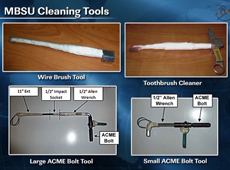
EVA tools built (courtesy: JAXA/NASA)
![]()
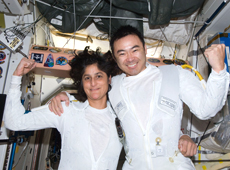
Astronauts Hoshide and Williams after completing the installation of a spare MBSU (courtesy: JAXA/NASA)
We ended up using one of our spare toothbrushes. But we couldn’t just use it as it was. The toothbrush was modified to be easier to use with spacesuit gloves. On the ground, they tested it in a thermal-vacuum environment. We also needed another tool because a toothbrush alone wouldn’t be enough to remove all the metal shavings, because it couldn’t reach the bottom of the bolt hole. So we used a spare power cable to make a wire brush. The ground team made a video to show us how to build them. Despite the fact that this fell on a long weekend in the U.S., they came in and worked hard to prepare for the EVA.
So how did your second spacewalk go?
We cleaned the bolt hole, lubricated it, and drove in the bolt. We progressed little by little, getting instructions from the ground like, “Turn the bolt slightly. When it cannot go farther, turn it back.” or “Next, pick up the second tool.” When we reported that the bolt was finally completely screwed in, I heard applause in the background, through our headsets. This made me very happy because I felt that everyone’s thoughts and efforts contributed to the successful installation.
This reminds me of the Apollo 13 accident. When the oxygen tank exploded, the ground team solved the problem by coming up with an idea to improvise a replacement using whatever was available in the spacecraft.
Exactly. The MBSUs are very important systems, because they distribute power to the ISS. So, because we needed an emergency fix, the ground team worked on their days off. To tell you the truth, I almost had tears in my eyes when I heard the applause in the flight control room, knowing what they have done. (laugh) As soon as we got back inside and took off our spacesuit, we talked to the folks on the ground by videoconference. Everyone had big smiles on their faces! When I saw this, I really felt happy that we successfully installed the MBSU.
Now let me ask about spacesuits. Is there a trick to wearing a spacesuit comfortably?
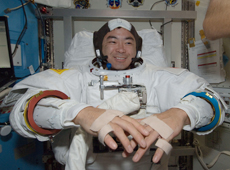
Astronaut Hoshide preparing for an EVA (courtesy: JAXA/NASA)
You don’t have much of a problem with the lower torso because you don’t walk in a weightless environment. On the other hand, the arms need to be able to move, with the right pressure at your fingertips, and everyone has their own preference. Due to the structure of the spacesuit, if you adjust it to fit perfectly when your arms are extended horizontally, it will create gaps at the end of your fingers when your arms are bent, and your hands in front of you. On the other hand, if you adjust the length with your arms bent so the pressure on your fingertips are just right, you may feel some pain on your fingertips against the gloves when your arms are extended. Which to choose is up to each individual. For me, I wanted to be able to use tools easily, so I adjusted the gloves to be most comfortable when my arms were bent.
Bearings are used in the shoulder joints, which limit the direction of movement. If you try to move your shoulders against them, you will be fighting against the spacesuit, which leads to wasting your energy. Through training, astronauts learn how to move efficiently and smoothly, without fighting against the spacesuit.
You do have to learn how to work in a space suit. Some people are quick learners, but in my case, I learned the techniques little by little, making a lot of mistakes.
On your first spacewalk, you tethered the MBSU to the ISS handrail. Is it possible to do delicate work with spacesuit gloves on?
The tips of our gloves are made of a rubber-based material, so you can feel a little, but the gloves are not designed for delicate work. Although the tether we used were designed and built for EVA, it was hard to fold the tethers neatly, so I ended up leaving the extra tether a little messy. That was partly because of the weightless environment. It is hard to fold your clothes neatly even inside the ISS.
A spacesuit is sometimes called a “mini Earth.” Did you feel that way in space?

Astronaut Hoshide during an EVA (courtesy: JAXA/NASA)
It’s rather a “small spacecraft” than a “mini Earth.” A spacesuit is packed with a variety of technologies, such as a life support system with oxygen supply, carbon dioxide removal system, cooling system, and communication system. So, in that sense, a spacesuit really is like a small spacecraft. But when I was working inside the spacesuit in space, I was able to just concentrate on my tasks without being reminded of all that. I think that tells you how reliable the technology is.
How do you think the current spacesuits can be improved to be more wearer-friendly?
I can think of many improvements, in terms of the function of spacesuits, including the operability of the gloves. Another important improvement is to shorten the time needed for prebreathe before the EVA. We tried a newer method but it still took a long time. Spending a significant amount of time on preparation is inefficient. I hope it will become possible to immediately go outside the spacecraft in case of emergency.
Can you talk during a spacewalk?
The communication system allows conversations between four parties: Suni, the crew inside the ISS, the flight control team in Houston, and myself. For example, when Suni was talking to Houston, I listened quietly to follow what was going on. Also, while the robotic arm is moving close to the ISS structure, everybody needs to be quiet for safety reasons. There are rules like these, but when we were just simply working, Suni and I sometimes chatted, saying things like, “What are you doing now?” or “Take a look. The Earth is so beautiful.” We also sometimes told jokes and had some laughs.
The ground team can hear all this?
Yes. So you cannot tell bad jokes. (laugh)
Can they watch you working, too?
Basically they can. There are many cameras on the external structure of the ISS, and also a camera is mounted on each spacesuit helmet so the ground team can have a close-up view of the operation. I was not especially bothered by all this because I was concentrating on my tasks. Cameras are also installed inside the ISS. You need to remember not to pass in front of them naked. (laugh)
How did the Earth look to you during your spacewalks?
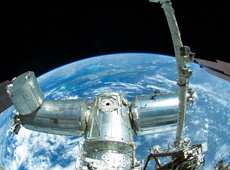
Picture taken during the EVA. KIBO is seen on the left. (courtesy: JAXA/NASA)

Astronaut Hoshide being carried on the ISS robotic arm (courtesy: JAXA/NASA)
When I was on the robotic arm, Joe Acaba was flying the robotic arm from inside the ISS. Before the EVA, Joe and I reviewed how the arm would move through computer simulation. But I was paying attention to things like clearance to structure, not to what I would see in free space.
It was on the day of my first spacewalk. I was on the robotic arm, picked up the failed MBSU, and Joe started to move me. In the middle of the way, I suddenly saw the front of KIBO. That meant that I was in front of the front part of the ISS. I was a little puzzled for a moment. I moved the MBSU to the side, and looked straight ahead. There was nothing between myself and space! I was only able to see the Earth and space in front of me! I had seen the Earth and space from inside, but it was always through the windows of the ISS, and there was always a window frame or part of the structure in my sight. But this time, although it was just for a few minutes, there was not a structure in my field of view, there were just Earth and space. It was very moving. I almost opened my arms wide like the famous scene from the movie Titanic. (laugh)
Looking back on your spacewalks now, is there anything you would like to do differently next time?
If I can do a spacewalk again, I would like to take a lot more pictures. I took many pictures this time, too. Some pictures were technical pictures to help explain the problem with the MBSU, others are pictures of Suni working, the Earth, the ISS and myself, for example. But after coming back inside ISS, I realized that I could have taken a lot more pictures, because there was still space left on my camera’s memory card. Of course, successfully and safely completing the task is the priority, but I would like to take many pictures if I have spare time.
What are your goals for the near future?
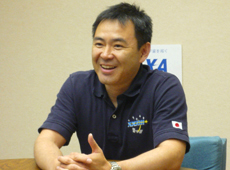
I would like to share my experience with many people. Astronauts Koichi Wakata and Kimiya Yui are scheduled for long-duration missions on the ISS, so I would like to support them. And eventually I hope I can go back to space again and use the experience I’ve gained to further contribute to the ISS program. There are also ideas for going beyond the orbit of the ISS – to the Moon, to an asteroid, and to Mars. These projects cannot happen without international collaboration. Japan has very advanced technology, so it should contribute to these projects as well. I hope to be a part of it.
Do you have any messages for young people based on your experience on the last mission?
There is a lot I want to say to them, but most importantly, not to give up. Even when things aren’t going well, or not the way you planned, it is important to never give up, and to try to work with others to overcome the challenge. When people work together, you can conquer anything. One of the best examples of that was the installation of the spar MBSU. So many people worked very hard, without days off, and succeeded in the end. It was a truly profound experience for me. What made me very happy was not my having performed EVAs, but the power and thoughts of the team. No matter what you may run into in the future, I hope that you will try to overcome it, collaborating with your peers.
Astronaut, Flight Crew Operations and Technology Department, Human Spaceflight Mission Directorate, JAXA
Mr. Hoshide received a bachelor’s degree in Mechanical Engineering from Keio University in 1992, and a master of science in Aerospace Engineering from the University of Houston, Cullen College of Engineering, in 1997. From 1992 to 1994, he was involved in the development and supervision of the H-II rocket at the Nagoya office of NASDA (now JAXA). From 1994 to 1999, he worked as an astronaut support engineer at the Tsukuba Space Center and NASA’s Johnson Space Center. In February 1999, he was named one of Japan’s astronaut candidates for the International Space Station, and was certified as an astronaut in January 2001. He was certified as a Soyuz-TMA Flight Engineer in May 2004, and as a Mission Specialist by NASA in February 2006. In June 2008, he flew to the ISS aboard the space shuttle Discovery on mission STS-124 (1J), and installed the Pressurized Module of the Japanese Experiment Module KIBO. From July to November 2012, he stayed on the ISS for 124 days as a flight engineer on the Expedition 32/33 mission. His mission included experiments, ISS maintenance, and three extravehicular activities.
Go for Space!
A Mini Spaceship for One
Building a Good-Looking Spacesuit
Building a Better Spacesuit with Medicine
